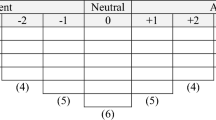Abstract
Earlier studies on cognitive preferences have concentrated on students, whereas the subjects here are teachers of science. The study seeks to compare how cognitive preferences differ in groups of secondary school teachers identified by type of curriculum taught (traditional vs. enquiry-oriented), gender, length of teaching experience, and educational qualification.
The Combined Cognitive Preference Inventory compiled by Pinchas Tamir was applied to 103 subjects drawn by random cluster sampling from urban schools. Inferential statistical analysis was employed, with a matched group design. With few exceptions the overall pattern of cognitive preferences that emerged for all the groups is Recall-Principles-Application-Questioning. These results do not confirm anticipated differences, and bring home the fact that teachers' congnitive preferences remain constant. The implications for implementation of innovative curricula and teacher education are discussed.
Zusammenfassung
Frühere Studien über kognitive Präferenzen konzentrierten sich auf Studenten, während Thema dieses Artikels Lehrer im wissenschaftlichen Bereich sind. Die Studie will einen Vergleich anstellen, wie kognitive Präferenzen sich nach Gruppen von Sekundarschullehrern unterscheiden, die nach verschiedenen Kriterien wie Art des unterrichteten Curriculums (traditionell gegen Frageorientierte), Geschlecht, Länge der Berufserfahrung und Qualifikationen bestimmt wurden.
Das von Pinchas Tamir aufgestellte zusammengefaßte Inventar der kognitiven Präferenzen wurde bei 103 Lehrern an städtischen Schulen durch Zufallsstichprobenerhebung angewandt. Eine zu Schlußfolgerungen führende statistische Analyse wurde erstellt, und zwar mit einem matched group design (parallelisiertes Gruppendesign). Das sich mit wenigen Ausnahmen für alle Gruppen ergebende Grundmuster der kognitiven Präferenzen ist Erinnerung-Grundsätze-Anwendung-Fragestellung. Diese Ergebnisse bestätigen die angenommenen Unterschiede nicht, und sie lassen erkennen, daß die kognitiven Präferenzen der Lehrer konstant bleiben. Die Auswirkungen auf die Einführung innovativer Curricula und auf die Lehrerausbildung werden diskutiert.
Résumé
Les études effectuées sur les préférences cognitives étaient focalisées au départ sur les apprenants, tandis que les questions étudiées ici portent sur les enseignants de science. La présente étude tente d'établir une comparaison entre les préférences cognitives des différents groupes d'enseignants du secondaire qui ont été identifiés d'après le type de programme enseigné (programme traditionnel contre programme orienté vers la recherche), le sexe, la longueur de l'expérience didactique et les qualifications pédagogiques.
L'inventaire des préférences connitives combinées compilé par Pinchas Tamir a été appliqué à 103 matières sélectionnées au hasard à partir d'un échantillonnage d'écoles urbaines. On a employé l'analyse statistique déductive, avec un plan de groupe correspondant. Mises à part quelques exceptions, la structure générale des préférences cognitives qui s'est dégagée pour tous les groupes est la suivante: Rappel-Principes-Application-Interrogation. Ces résultats ne corroborent pas les différences anticipées et font comprendre le fait que les préférences cognitives des enseignants sont constantes. On examine les implications de ces résultats pour la mise en oeuvre de programmes d'étude novateurs et la formation des formateurs.
Similar content being viewed by others
References
APEID. 1980. Biology Education in Asia. Report of Regional Workshop. Bangkok: Unesco Regional Office for Education in Asia and the Pacific.
Bagchi, J. P. 1985. Indian Biology Textbooks in Sex Education, A Comparative Study.Journal of Science and Mathematics Education in South East Asia 8: 18–23.
Best, J. W. 1983.Research in Education, 4th edition, New Delhi: Prentice Hall of India.
Brown, S. A. 1975. Cognitive Preferences in Science: Their Nature and Analysis.Studies in Science Education 2: 43–65.
Government of India. 1968.National Policy on Education. New Delhi: Ministry of Education and Social Welfare. Publication No. 1110.
—. 1985.Challenge of Education — a Policy Perspective. New Delhi: Ministry of Education. Publication No. 1517.
—. 1986.National Policy on Education. New Delhi: Ministry of Human Resource Development, Department of Education. Publication No. 1539.
Harris, C. W. 1974. Problems of Objectives Based Measurement. In: Harris, C. W., Alkin, M. C. and Popham, W. J. eds.Problems in Criterion Referenced Measurement. Los Angeles: Center for the Study of Evaluation, University of California.
Heath, R.W. 1964. Curriculum, Cognition and Educational Measurement.Educational and Psychological Measurement 24: 239–53.
Johri, B. M. and Lal, M. 1967. Biology in Indian High School.School Science 5: 1–16.
Kempa, R. F. and Dube, G. E. 1973. Cognitive Preference Orientation in Students of Chemistry.British Journal of Educational Psychology 43: 279–88.
Rathore, H. C. S. and Singh, A. P. 1987. Cognitive Preferences and Academic Achievement of Tenth Grade Biology Studients.Indian Educational Review 22: 29–37.
Saxena, A. K. 1986. Attitude towards Physics and Cognitive Preference Styles among Different Groups of Science Students.Indian Dissertation Abstracts (July–Sept.): 307–20.
Tamir, P. 1975. The Relationship among Cognitive Preference School Environment, Teachers' Curricular Bias, Curriculum and Subject Matter.American Educational Research Journal 12: 235–64.
— 1976. The Relationship between Achievement in Biology and Cognitive Preference Style in High School Students.British Journal of Educational Psychology 46: 57–67.
— 1977. A Note on Cognitive Preferences in Science.Studies in Science Education 4: 111–21.
— 1985. Meta-Analysis of Cognitive Preferences and Learning.Journal of Research in Science Teaching 22: 1–17.
Tamir, P. and Jungwirth, E. 1984. Test Scores and Associations as Measures of Cognitive Preferences.Studies in Educational Evaluation 10: 149–58.
van den Berg, E., Lunetta, V. N. and Tamir, P. 1978. Cognitive Preferences: A Validation Study. Paper delivered at the annual meeting of the National Association for Research in Science Teaching Toronto, Ontario.
Rights and permissions
About this article
Cite this article
Bagchi, J.P., Uddin, H. Cognitive preferences of secondary science teachers in India: The example of uttar pradesh. Int Rev Educ 36, 453–467 (1990). https://doi.org/10.1007/BF01874753
Issue Date:
DOI: https://doi.org/10.1007/BF01874753




